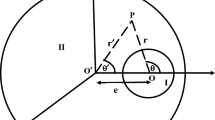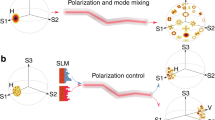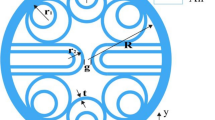Abstract
Polarization properties of chiral fiber gratings with the core enclosed by a non-circular equiwidth curve have been analyzed and examined numerically. Since the curve has multiple odd number degree of symmetries, the specific analysis is mainly based on the simplest triple-helix chiral fiber gratings and difference of properties caused by small geometric deformation. Results show that, only right-handed circularly polarized core modes couples with cladding modes. Besides, if the shape of the fiber core was closer to a circle, rather than a triangle with curved edges, both the shortest total power transfer length and the distance between the relevant resonant dips of the transmission spectrum would increase. Therefore, as a multiple-helix chiral fiber grating, it might have some potential applications, such as filters, polarizers, and sensors.




Similar content being viewed by others
Availability of data and materials
All of the data and material are owned by the authors.
References
Baillif, M.: Curves of constant diameter and inscribed polygons. Elem. Math. 64, 102–108 (2009)
Barrallo, J., González-Quintial, F., Sánchez-Beitia, S.: An introduction to the Vesica Piscis, the reuleaux triangle and related geometric constructions in modern architecture. Nexus Netw. J. 17, 671–684 (2015). https://doi.org/10.1007/s00004-015-0253-9
Bing, P., Huang, S., Guo, X., Zhang, H., Tan, L., Li, Z., Yao, J.: Analysis of a photonic crystal fiber sensor with reuleaux triangle. Curr. Opt. Photon. 3, 199–203 (2019). https://doi.org/10.1364/COPP.3.000199
Euler, L.: De curvis triangularibus. Acta Acad. Petropol. 1778, 13–30 (2019)
Fu, C., Wang, Y., Bai, Z., Liu, S., Zhang, Y., Li, Z.: Twist-direction-dependent orbital angular momentum generator based on inflation-assisted helical photonic crystal fiber. Opt. Lett. 44, 459–462 (2019). https://doi.org/10.1364/OL.44.000459
Hu, X., Li, N., Liu, B.Y.: Simulation and application of reuleaux triangle in geometric measurement. IOP Conf. Earth Environ. Sci. 310, 022028 (2019). https://doi.org/10.1088/1755-1315/310/2/022028
Jiang, C., Liu, Y., Huang, L., Mou, C.: Double cladding fiber chiral long-period grating-based directional torsion sensor. IEEE Photonics Technol. Lett. 31, 1522–1525 (2019a). https://doi.org/10.1109/LPT.2019.2936209
Jiang, C., Liu, Y., Zhao, Y., Mou, C., Wang, T.: Helical long-period gratings inscribed in polarization-maintaining fibers by CO2 Laser. J. Lightwave Technol. 37, 889–896 (2019b). https://doi.org/10.1109/JLT.2018.2883376
Jiang, Y., Geng, X., Luo, S.: Li, L: Design and analysis of a step-index fiber with a Reuleaux triangular core. Opt. Quant. Electron. 55, 1040 (2023). https://doi.org/10.1007/s11082-023-05271-0
Kopp, V.I., Genack, A.Z.: Double-helix chiral fibers. Opt. Lett. 28, 1876–1878 (2003). https://doi.org/10.1364/OL.28.001876
Kopp, V.I., Churikov, V.M., Singer, J., Chao, N., Neugroschl, D., Genack, A.Z.: Chiral fiber gratings. Science 305, 74–75 (2004). https://doi.org/10.1126/science.1097631
Kopp, V.I., Churikov, V.M., Zhang, G., Singer, J., Draper, C.W., Chao, N., Neugroschl, D., Genack, A.Z.: Single- and double-helix chiral fiber sensors. J. Opt. Soc. Am. B 24, 48–52 (2007). https://doi.org/10.1364/JOSAB.24.000A48
Krivov, D.A.: Modeling the stress–strain state of plates in a form of Reuleaux Triangle profile during grinding of plastic materials. IOP Conf. Mat. Sci. Eng. 1181, 012020 (2021). https://doi.org/10.1088/1757-899X/1181/1/012020
Liu, Z., Liu, C., Zhang, Y., Zhang, Y., Yang, X., Zhang, J., Yang, J., Yuan, L.: Fiber-based helical channels refractive index sensor available for microfluidic chip. IEEE Photonics Technol. Lett. 29, 2087–2090 (2017). https://doi.org/10.1109/LPT.2017.2765314
Liu, Z., Zhu, G., Li, Y., Yu, J., Bai, Z., Liu, S., He, J., Wang, Y.: Orthogonal long-period fiber grating for directly exciting the orbital angular momentum. Opt. Express 28, 27044–27051 (2020). https://doi.org/10.1364/OE.399929
Polster, B.: Kenichi Miura’s water wheel, or the dance of the shapes of constant width. Best Writ. Mathemat. 2015, 119–131 (2016)
Qian, J.R., Su, J., Xue, L.L., Yang, L.: Coupled-mode analysis for chiral fiber long-period gratings using local mode approach. IEEE J. Quantum Electron. 48, 49–55 (2012). https://doi.org/10.1109/JQE.2011.2176923
Ryu, J., Lee, J., Yi, C., Kim, J., Lee, I.G., Kim, H.S., Kim, S.B., Wang, K., Oh, R., Kim, C.M.: Chirality of a resonance in the absence of backscatterings. Opt. Express 25, 3381–3386 (2017). https://doi.org/10.1364/OE.25.003381
Shen, X., Hu, X., Yang, L., Dai, N., Wu, J., Zhang, F., Peng, J., Li, H., Li, J.: Helical long-period grating manufactured with a CO2 laser on multicore fiber. Opt. Express 25, 10405–10412 (2017). https://doi.org/10.1364/OE.25.010405
Shvets, G., Trendafilov, S., Kopp, V.I., Neugroschl, D., Genack, A.Z.: Polarization properties of chiral fiber gratings. J. Opt. A Pure Appl. Opt. 11, 074007 (2009). https://doi.org/10.1088/1464-4258/11/7/074007
Tran, T.T., He, J., Rondinelli, J.M., Halasyamani, P.S.: RbMgCO3F: a new beryllium-free deep-ultraviolet nonlinear optical material. JOSAC 137, 10504–10507 (2015). https://doi.org/10.1021/jacs.5b06519
Wang, P., Zhao, H., Detani, T., Li, H.: Simultaneous generation of the first-and second-order OAM using the cascaded HLPGs. IEEE Photonics Technol. Lett. 32, 685–688 (2020). https://doi.org/10.1109/LPT.2020.2991934
Webster, A.: The electromagnetic properties of aperture-synthesis telescopes shaped as Reuleaux triangles. Mon. Not. r. Astron. Soc. 353, 1304–1310 (2004). https://doi.org/10.1111/j.1365-2966.2004.08158.x
Xian, L., Wang, D.: Li, L: Torsion and strain simultaneous measurement using a cascaded helical long-period grating. J. Opt. Soc. Am. B 37, 1307–1311 (2020). https://doi.org/10.1364/JOSAB.381406
Xu, H., Yang, L., Han, Z., Qian, J.R.: Higher-order mode couplings in double-helix chiral long-period fiber gratings. Opt. Commun. 291, 207–214 (2013). https://doi.org/10.1016/j.optcom.2012.10.082
Funding
This work is supported by the National Natural Science Foundation of China (No. 62105153).
Author information
Authors and Affiliations
Contributions
YJ wrote the main manuscript text. All authors reviewed the manuscript.
Corresponding author
Ethics declarations
Competing interests
The authors declare no competing interests.
Human or animal rights
No human and/or animal studies.
Consent to participate
All authors are agreed and gave their consent to participate in this research work.
Additional information
Publisher's Note
Springer Nature remains neutral with regard to jurisdictional claims in published maps and institutional affiliations.
Appendix A
Appendix A
In this appendix the fields of the core and the cladding modes in a step index fiber are summarized. An approximate model for cladding modes can be applied to suggest an analytical expression in the theoretical analysis in the limit of a wide-cladding radius (Rcl >> λ) and small index contrast (nco − ncl << ncl). With the initial small core neglected, the analytical expressions of the core and the cladding modes are in the same form, except that index profiles for the core and the cladding modes are different. Since the eigenmodes of the HEl+1,m and EHl−1,m are degenerated, only expressions for the HE modes are listed as follows:
In Eqs. (A1), the upper and lower expressions in the same curly bracket indicate the even and odd modes, respectively.
In the above equations,
Then we define \({\text{HE}}_{lm}^+\) and \({\text{HE}}_{lm}^-\) as
where the superscripts + or − indicate the modes with positive or negative angular number as shown in Eq. (A5), and modes with the superscripts even or odd are the even or odd modes in Eqs. (A1). Substituting Eqs. (A1) into Eq. (A4), the mode expressions in Eq. (A4) become
We will use the mode expression defined in Eq. (A5) for coupled-mode analysis. In the zero-order approximation, \({\text{HE}}_{lm}^+\) is left-handed circularly polarized modes, and \({\text{HE}}_{lm}^-\) is right-handed circularly polarized modes.
Rights and permissions
Springer Nature or its licensor (e.g. a society or other partner) holds exclusive rights to this article under a publishing agreement with the author(s) or other rightsholder(s); author self-archiving of the accepted manuscript version of this article is solely governed by the terms of such publishing agreement and applicable law.
About this article
Cite this article
Jiang, Y., Luo, S. & Li, L. Coupled-mode analysis for chiral fiber gratings with a core enclosed by a non-circular equiwidth curve. Opt Quant Electron 56, 900 (2024). https://doi.org/10.1007/s11082-024-06755-3
Received:
Accepted:
Published:
DOI: https://doi.org/10.1007/s11082-024-06755-3




